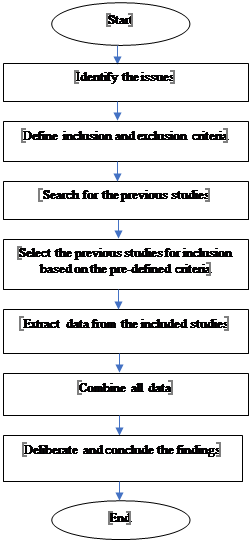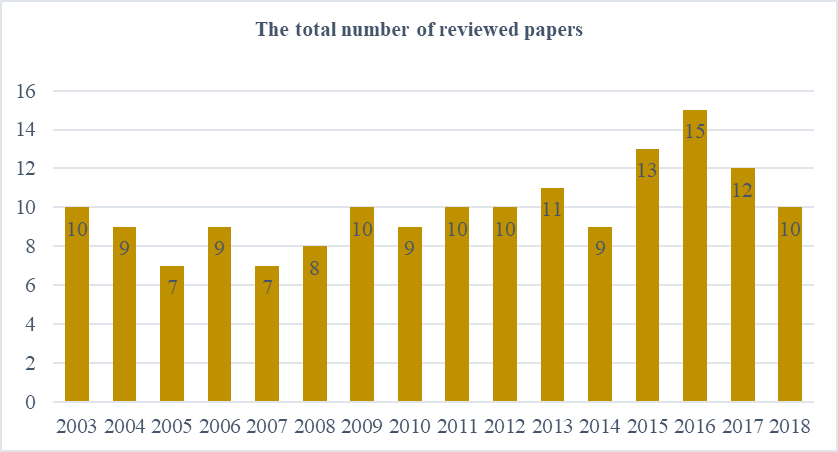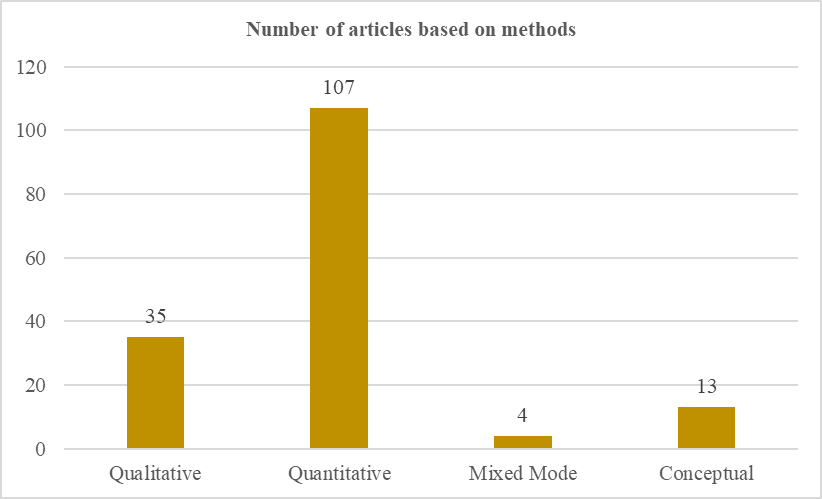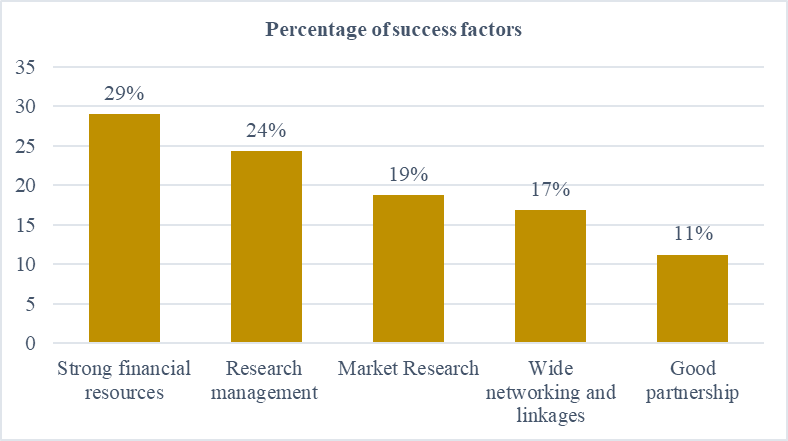Abstract
The evolution of science and technology nowadays leads to the fast development of research institutions around the world. Developing new products or technologies and moving them into a market place efficiently and effectively are essential in gaining a competitive edge to ensure a long term success. The level of public value is important in order for the potential products and technologies are eligible for commercialization as it could result in overall profitability. The purpose of this paper is to illustrate the critical success factors on the research commercialization that can assist organizations to identify the key elements for a successful process. The success factors are derived from 159 research articles that were published from 2003 to 2018 from several databases like Web of Science and Scopus. Based on the systematic literature review (SLR) method, there are five elements that have been recognized as successful commercialization in the research and innovation product. The key success factors are by having strong financial resources, good management skills, market research, wide networking and linkages and good partnerships.
Keywords: CommercializationInnovationResearch ManagementNew Product DevelopmentSuccess Factors
Introduction
The process of a new product or service introduced to the market is called commercialization (Adams, Bessant, & Phelps, 2006). The commercialization of product or technology is like an engine of growth for the nation in the globalized economy. Commercialization is one of the activity in the product innovation. Commercialization generally is the final process where the actual product launching is at the final stage of the product development. Figure

Commercialization is a part of research and development process. The research phase is incomplete without the commercialization of that particular of research product. It is important to introduce new products to the market as it will contribute to the growth of the economies (Crawford & Benedetto, 2010). In addition, the importance of the commercialization can be seen through the establishment of the spin-off companies by many universities (Steffensen, Rogers, & Speakman, 1999) and its contribution to the development towards local economy (Etzkowitz, 2003; S. A. Shane, 2004). Other important of commercialization is it help to generate income for the organizations as it can create new businesses and job opportunities (S. Shane, 2004; Shane & Cable, 2002; S. A. Shane, 2004). As for the policy makers, they have recognized the influence of the science park like a Science Park in Cambridge, UK as a source of the industrial innovations that could trigger and provide job opportunities (Etzkowitz, 2003). As in Malaysia, the establishment of Pusat Sains Negara, Taman Teknologi Malaysia and Putra Science Park are one of the government initiative to expand knowledge in Science and Technology by creating and promoting awareness and interest among Malaysian citizens.
Problem Statement
There is no clear process on how an invention or innovation gets to market and succeeds. It is believed that the success of the commercialization always involves the market throughout the whole process (Natsheh, Gbadegeshin, Rimpiläinen, & Zambrano, 2015). Throughout this process, there are factors that affecting the success of the commercialization. Based on the input provided by the research department in Universiti Teknologi Petronas (UTP), the main problem in commercialization is the financial support. In view of the current global economy situation, it is hard to secure funding from the industries which the allocation for the research now is limited. This is due to the effect from the current economy crisis around the world. At this time, the technology transfers office (TTO) is a very important department in assisting researchers and university in order to sustain the research commercialization activities. One of the TTO role is to manage the Intellectual Property (IP) of the research product (Crawford & Benedetto, 2010). The improper management of the intellectual property (IP) and protection will delay in the process of diffusion of the technology from universities to industries and leads to the problem in technology transfer process (Caulfield & Ogbogu, 2015; Wonglimpiyarat, 2014a, 2014b). Other problem that the research institution mostly faces is the lack of the university engagement with government and industries which are leads to the less emphasis for commercialization (Kaur et al., 2014; Rasmussen, 2008). Other important criteria that the research institution should have for a successful commercialization is by having skills or expert peoples in the organization (Khademia, Ismaila, Leeb, & Shafaghatc, 2015; Sidek, Ismail, & Mohd Nor, 2014). It is difficult to assess the strength of the research product if there are less number of experts and skills people in the organization. In addition, without these experts, it is difficult to identify potential collaborators or buyers as they are very familiar with the eco-system.
Table
Research Questions
The following are the research questions in conducting the research study;
What are the success factors identified in the earlier researches on the commercialization?
What are the highest and the lowest variable of the success factors found from the studies?
Purpose of the Study
The main purpose of this study is to identify the success factors addressed by the previous researchers on the research commercialization. Furthermore, the study was to determine the most success factors that the most authors highlighted in their research study. The outcome from the study will assist policy makers and researchers to moving forward for successful commercialization.
Research Methods
The literature review is the key start of the research work where the information was gathered and brainstormed the ideas to make the research more impactful. The Systematic Literature Review (SLR) was used to compile all the data. In this study a total of 159 articles have been categorized. The research is based on the process flow chart as in Figure

Findings
Overview of Studies
Based on the studies, the topic on the commercialization has attracted so many scholars from local and abroad. Figure

Figure

Research Commercialization Success Factors
The main goal of this paper is to study the most critical success factors of the research commercialization. Therefore, the studies were then furthered by screening the results based on the quantitative methods as this were given the very significant results to the main goal. As a results, there are five factors that contribute to the biggest success in the commercialization of research product. The factors are by having a strong financial resources, good research management, market research, networking and linkages, and good partnership. Figure

Based on Figure
The second highest of key success factor as per studies is 24% of good research management skills. Many studies shows the research management skill is capable in commercializing the research product (Mian, Lamine, & Fayolle, 2016; Mishra & Saji, 2013; Narayanan & O'Connor, 2010; Simula, 2012; Thorbun, 2000). As for the example, Technology Transfer Office (TTO) is handling the commercialization unit at the universities. TTO is established to encourage researchers and inventors to implement the commercialization strategies as well as support them in the process of the commercialization (O’Gorman, Byrne, & Pandya, 2006). TTO also support in many aspects such as in the management of the intellectual property right (IPR) (Hsu, Shen, Yuan, & Chou, 2015) and managing the contract research agreement with the industries and licensees. A good management by the TTO accelerates the process of the commercialization effectively and efficiently thus enable to the successful commercialization.
The market research is also identified as a key factor of the research commercialization with 19% of the study. Normally, the research team starts the process with identifying the research problem. By recognizing the problem, they will find the solution for it (Hindle & Yencken, 2004). As studied by (Sidek et al., 2014), there are seven guidelines in identifying the product within the eco-system; identify the problem that the researcher intended to solve, identify the people who benefited from the product, identify the user of the product, identify the purchaser of the product and develop networking in the product eco-system.
Networking is one of the element for a successful commercialization (Aarikka-Stenroos & Sandberg, 2012; Bøllingtoft, 2012; Lee & Park, 2006). The figure shows that 17% of the studies have stressed that the networking is a key factor for the organizations to move forward. Through networking, the organizations are linking to the financiers which will enable the access to a broader network such as suppliers, customers and other resources (S. A. Shane, 2004). The networking through collaboration with the universities, industries and government will give a greater chance for the inventions for marketable (Thursby, Jensen, & Thursby, 2001).
The least discussed area is on the partnership. A good partnership is one of the key factor with 11% of studies. It is important to choose the right partner (Aziz & Norhashim, 2011; Nor Kamariah Kamaruddin, 2013; Putit, Hasan, Suki, & Shahbodin, 2014) in order for the project to progress smoothly. The partner should be necessarily competent in marketing as well as sales, in order to market and sell the product. They also should have a technical basic knowledge in convincing the potential buyer. According to (Sidek et al., 2014), a good business partner have all these attributes; transparent and trustworthy, basic technology knowledge, available in providing the financial support, good marketing and sales skills, and able to share common goals and interest.
Conclusion
Based on the findings, instead of developing an innovative product, the organizations should have a strong financial resources, good management skills, market research, wide networking and linkages with internal and external parties and good partnerships in order to successfully commercialize their product. These are the most important elements that the study found for the benefit of researchers in any organizations or research institutions to move forward.
Acknowledgments
Special appreciation and honor to the faculty of Razak School of Engineering and Advance Technology, Universiti Teknologi Malaysia and Universiti Teknologi PETRONAS for providing necessary and invaluable facilities in the completion of this study.
References
- Aarikka-Stenroos, L., & Sandberg, B. (2012). From new-product development to commercialization through networks. Journal of Business Research, 65(2), 198-206. doi:
- Adams, R., Bessant, J., & Phelps, R. (2006). Innovation management measurement - A review. International Journal of Management Reviews, 8(1), 21-47.
- Aziz, K. A., and, H. H., & Norhashim, M. (2011). University Research, Development & Commercialisation - A Malaysian Best Practice Case Study. World Review of Business Research, Vol. 1. No. 2., Pp. 179 - 192.
- Bøllingtoft, A. (2012). The Bottom-Up Business Incubator: Leverage to Networking and Cooperation Practices in A Self-Generated, Entrepreneurial-Enabled Environment. Technovation, 32(5), 304-315. doi:
- Caulfield, T., & Ogbogu, U. (2015). The commercialization of university-based research: Balancing risks and benefits. BMC Med Ethics, 16(1), 70. doi:
- Crawford, M., & Benedetto, A. D. (2010). New Products Management (10th ed.). New York: McGraw Hill.
- Etzkowitz, H. (2003). MIT and the Rise of Entrepreneurial Science. New York: Taylor & Francis Group.
- Hindle, K., & Yencken, J. (2004). Public research commercialisation, entrepreneurship and new technology based firms: an integrated model. Technovation, 24(10), 793-803. doi:
- Hsu, D. W. L., Shen, Y.-C., Yuan, B. J. C., & Chou, C. J. (2015). Toward successful commercialization of university technology: Performance drivers of university technology transfer in Taiwan. Technological Forecasting and Social Change, 92, 25-39. doi:
- Kaur, I. P., Kakkar, V., Deol, P. K., Yadav, M., Singh, M., & Sharma, I. (2014). Issues and concerns in nanotech product development and its commercialization. J Control Release, 193, 51-62. doi:
- Khademi, T., & Ismail, K. (2013). Commercialization Success Factors of University Research Output. Jurnal Teknologi.
- Khademia, T., Ismaila, K., Leeb, C. T., & Shafaghatc, A. (2015). Enhancing Commercialization Level of Academic Research Outputs in Research University. Jurnal Teknologi, Pp. 141 - 151.
- Lee, J.-d., & Park, C. (2006). Research and development linkages in a national innovation system: Factors affecting success and failure in Korea. Technovation, 26(9), 1045-1054. doi:
- Mian, S., Lamine, W., & Fayolle, A. (2016). Technology Business Incubation: An overview of the state of knowledge. Technovation, 50-51, 1-12. doi:
- Mishra, S. S., & Saji, K. B. (2013). Moderating roles of organizational inertia and project duration in the NPD process: an empirical investigation. Journal of Product & Brand Management, Volume 22(1), 52-63. doi:
- Narayanan, V. K., & O'Connor, G. C. (2010). Encyclopedia of technology and innovation management: John Wiley & Sons.
- Natsheh, A. A., Gbadegeshin, S. A., Rimpiläinen, A., & Zambrano, A. (2015). Identifying the Challenges in Commercializing High Technology A Case Study of Quantum Key Distribution Technology. Technology Innovation Management Review, 26-36.
- Nor Kamariah Kamaruddin, A. S. (2013). A Case Study Of R&D Technology Commercialisation: Challenges, Issues And The Way Forward. Paper presented at the 2nd International Conference on Technology Management , Business and Entrepreneurship.
- O’Gorman, C., Byrne, O., & Pandya, D. (2006). How Scientists Commercialise New Knowledge via Entrepreneurship. The Journal of Technology Transfer, 33(1), 23-43. doi:
- Putit, L., Hasan, H., Suki, A. A., & Shahbodin, F. (2014). Commercialization of University Research Products and Its Outcome On University Performance. International Journal of Engineering Business Management Studies, Pp. 483 - 495.
- Rasmussen, E. (2008). Government instruments to support the commercialization of university research: Lessons from Canada. Technovation, 28(8), 506-517. doi:
- Shane, S. (2004). Finding Fertile Ground: Identifying Extraordinary Opportunities for New Businesses: New York: Wharton Business School Publishing.
- Shane, S., & Cable, D. (2002). Network Ties, Reputation, and the Financing of New Ventures. Management science, 48(3), 364-381.
- Shane, S. A. (2004). Academic entrepreneurship: University spinoffs and wealth creation: Edward Elgar Publishing.
- Sidek, S., Ismail, N., & Mohd Nor, M. J. (2014). Determinants for a Successful Commercialisation of Technology Innovation from Malaysian Universities Paper presented at the ITMAR Conference.
- Simula, H. (2012). Management of Commersialization - Case studies of Industrial, Business to Business Product Innovation. (Doctoral ), Aalto University.
- Steffensen, M., Rogers, E. M., & Speakman, K. (1999). Spin-offs from Research Centers at A Research University. Journal of Business Venturing, 93-111.
- Thomas, D., Hansen, G. f., & Nordman, R. (2004). Commercialization Success in Early Stage Technology Companies. Rocket Builders.
- Thorbun, L. (2000). Knowledge management, research spinoffs and commercialization of R&D in Australia. Asia Pacific Journal of Management, 17, 257-275.
- Thursby, J. G., Jensen, R., & Thursby, M. C. (2001). Objectives, Characteristics and Outcomes of University Licensing: A Survey of Major U.S. Universities. Journal of Technology Transfer,.
- Wonglimpiyarat, J. (2014a). Incubator policy to support entrepreneurial development, technology transfer and commercialization. World Journal of Entrepreneurship, Management and Sustainable Development, 10(4), 334-351. doi:
- Wonglimpiyarat, J. (2014b). Technology Transfer and Entrepreneurial Development through University Business Incubation Process in Thailand. World Technopolis Review, 3(2), 78-88. doi:10.7165/wtr2014.3.2.78
Copyright information

This work is licensed under a Creative Commons Attribution-NonCommercial-NoDerivatives 4.0 International License.
About this article
Publication Date
17 May 2019
Article Doi
eBook ISBN
978-1-80296-061-7
Publisher
Future Academy
Volume
62
Print ISBN (optional)
-
Edition Number
1st Edition
Pages
1-539
Subjects
Business, innovation, sustainability, environment, green business, environmental issues
Cite this article as:
Mohd Zaki, N. A., Abd Rahim, A. R., & Mohd Hashim, F. (2019). A Systematic Revıew On The Critical Success Factor Of Research Commercialization. In M. Imran Qureshi (Ed.), Technology & Society: A Multidisciplinary Pathway for Sustainable Development, vol 62. European Proceedings of Social and Behavioural Sciences (pp. 9-17). Future Academy. https://doi.org/10.15405/epsbs.2019.05.02.2

